Hawthorne, New Jersey | 1959 – 1977
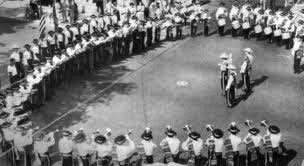 Over two decades, the Hawthorne Muchachos grew from a dream into a major contender in the competitive arena known as Drum & Bugle Corps. Over fifty years later, the mystique of the corps lives on, and the influence and changes brought to competition by the Muchachos are evident. From the uniqueness of the uniforms to the creative percussion and brass arrangements and the visual performances that changed the way the field of competition was to be used, each contribution by this drum corps helped move the activity forward in significant ways. Over two decades, the Hawthorne Muchachos grew from a dream into a major contender in the competitive arena known as Drum & Bugle Corps. Over fifty years later, the mystique of the corps lives on, and the influence and changes brought to competition by the Muchachos are evident. From the uniqueness of the uniforms to the creative percussion and brass arrangements and the visual performances that changed the way the field of competition was to be used, each contribution by this drum corps helped move the activity forward in significant ways.
In the early years, the Muchachos were portrayed as the “little Caballeros”. In the sixties they were described as the “fastest rising corps in the east”. By 1973, after a series of wins by both Hawthorne corps, Drum Corps News would print, “ In the east, the Muchachos of Hawthorne, New Jersey and their older brothers, the Caballeros, have swept (the competitions)”. Clearly, the Muchachos were recognized as a powerhouse with great potential.
 The Formative Years The Formative Years
The Muchachos were organized in January of 1959 under the auspices of the Hawthorne American Legion Post 199. Taking the lead in moving this organization along were Marge Moore and Ralph Silverbrand. Marge Moore was wife of a former Legion commander and Ralph Silverbrand was the respected drum major of the Hawthorne Caballeros – National and New Jersey State Champions over many years of competition. Assisting in the building of the corps were quality instructors including Joe Scarber, Jim Costello, Bob Costello and John McAuliffe.
The early Muchachos were a “blue collar” youth organization whose members were generally inexperienced in music and marching. However, due to the dedication of the staff and boys who joined in 1959, the unit was able to come together quickly, performing with some 65 members in the Pompton Plains Memorial Day parade a mere five months after their formation. The corps performed their first musical selection, “Honor Old Glory”, with 10 drummers, 40 bugles and 15 color guard. Parades were the bread and butter for the Muchachos over the next three years as they prepared for competition.
As a start-up organization, the uniforms needed to be manufactured by the Mothers Auxiliary and instruments were obtained from other corps that had disbanded. The first uniforms, similar to those of the Caballeros, were of Spanish style, although the festive yet simple sombreros and colorful serapes reflected a touch of Mexico. Black bell-bottom pants, white satin shirts and red cummerbunds completed the ensemble.
In 1960, the Muchachos traveled to Wildwood, N.J. to march in the American Legion State parade and came home with the first place trophy…..the first of many to be won over the coming years. In addition to the corps, the color guard entered their first state competition placing fourth overall.
 The Sixties – Rising Through The ranks The Sixties – Rising Through The ranks
As the corps prepared to enter the competitive activity, new instructors would be recruited to create the sound and look of this unique corps. Percussion was instructed by Art Mura while brass was instructed by Vic Cascella. Membership grew and the distinctive sound of the Muchachos began to take form. The repertoires took on a Latin flavor with charts including Adios Muchachos, Peanut Vendor and Manana.
The corps entered only one competition in 1961, the American Legions States, where they placed 12th in a field of 24 junior drum corps. The corps embraced a full season of competition in 1962. With a multitude of local drum corps in the area, the Muchachos, along with other corps, formed the Garden State Circuit. The Muchachos dominated the season going undefeated in circuit competition. Their second attempt at a Legion State title found them in 6th place…..a very respectable placement for this young corps. The Muchachos second undefeated season followed in 1963. The State competition in that year saw the corps in 5th place. And in this season, the decision was made to travel to Miami Beach, Florida to compete in their first American Legion National Championships where they placed sixth in the prelims and fourth in the finals.
 The following year, the Muchachos left the Garden State Circuit and began to compete against national powerhouse corps including the Blessed Sacrament Golden Knights, the St. Lucy’s Cadets and the Garfield Cadets. The corps was as of yet, no match for these competitors, but the experience of competition saw the corps improve with each performance. In 1964 the corps would compete in their second American Legion Nationals in Dallas, Texas where they placed second. They returned to New Jersey for the State competition, only to place fifth for the second year in a row. The following year, the Muchachos left the Garden State Circuit and began to compete against national powerhouse corps including the Blessed Sacrament Golden Knights, the St. Lucy’s Cadets and the Garfield Cadets. The corps was as of yet, no match for these competitors, but the experience of competition saw the corps improve with each performance. In 1964 the corps would compete in their second American Legion Nationals in Dallas, Texas where they placed second. They returned to New Jersey for the State competition, only to place fifth for the second year in a row.
During these early years, the Muchachos established themselves as a major force in Winter and Outdoor Color Guard competitions. The Metropolitan Circuit was captured by the guard in both 1964 and 1965. Upon entering the Liberty Color Guard Circuit, the Muchachos would be named as champions twice. In outdoor competition, the guard was the New Jersey State Champion three times. The precision and class shown by the color guard units were unmatched in competition.
1965 saw several additions to the corps including timbales to the percussion section and contra basses to the brass line. A change to the uniform included the addition of the bolero, a black, sequined vest that visually enhanced the corps on the field. New music and growing numbers helped the corps move forward. The corps traveled cross country in 1965 to compete in Portland, Oregon. The National Championships proved to be the highlight of 1965, as the color guard won the title in their guard competition.  The corps proper took third place as did the Caballeros in the senior division. The town of Hawthorne welcomed home the competitors with an evening parade that year. Both corps, it was realized, were putting the town of Hawthorne “on the map”. And once again, a fifth place in the States was awarded to the Muchachos. The corps proper took third place as did the Caballeros in the senior division. The town of Hawthorne welcomed home the competitors with an evening parade that year. Both corps, it was realized, were putting the town of Hawthorne “on the map”. And once again, a fifth place in the States was awarded to the Muchachos.
Although 1966 was a good year for the corps, their placement at the Nationals in Washington, D.C. was a disappointment. Placing tenth in the preliminaries would not be enough to move them into the finals competition. That year, in addition to the Eastern powerhouse corps, the contest would include several Midwest drum corps that were beginning to travel east in order to find more challenging competition. Among the forty-seven corps in prelims were the eventual champions, the Chicago Cavaliers and other famous units including the Casper Troopers, Chicago Royal Airs, Des Plaines Vanguard and Madison Scouts. 1966 was also a year where, during the season, all of the Jersey drum corps were taking turns outperforming each other and rankings changed almost weekly. By September, the Muchachos found themselves falling to Blessed Sacrament Golden Knights in the States, but beating the Garfield Cadets, St. Lucy’s Cadets and Blue Rock. The Muchachos were now recognized as one of the top corps in the east.
Boston, Massachusetts would have the Cavaliers again as National Champions in 1967 and the Muchachos would be on the outside looking in, as they placed ninth out of some fifty-five drum corps. They would place 12th in the CYO Nationals and would find themselves in the middle of the pack at all local competitions. The year was one of growing and refining the corps.
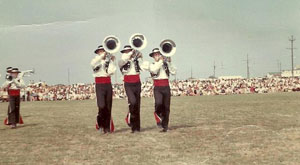 1968 was a year where 4th place seemed to be the corps placement in every show. In major competitions they traveled to Marion, Ohio for the U.S. Open Championships placing ninth out of twenty corps. Again, the exposure to the Midwest and now the Western corps was invaluable. At the U.S. Open, the Muchachos met up with the Blue Stars, the Madison Scouts and the Anaheim Kingsmen among others. The winter of 1968 – 1969 would see changes to the staff and to the direction of the music in the hope of becoming more competitive against the top corps in the West, Midwest and East. 1968 was a year where 4th place seemed to be the corps placement in every show. In major competitions they traveled to Marion, Ohio for the U.S. Open Championships placing ninth out of twenty corps. Again, the exposure to the Midwest and now the Western corps was invaluable. At the U.S. Open, the Muchachos met up with the Blue Stars, the Madison Scouts and the Anaheim Kingsmen among others. The winter of 1968 – 1969 would see changes to the staff and to the direction of the music in the hope of becoming more competitive against the top corps in the West, Midwest and East.
In 1969, the Muchachos were invited to the Dream competition in Jersey City. They placed 5th behind Blessed Sacrament, the 27th Lancers, the Garfield Cadets and St. Lucy’s Cadets. The American Legion Nationals were in Atlanta, Georgia that year. The Muchachos placed 6th. The year proved to be another of improvements with the guidance of their ambitious instructional staff, including Bobby Peterson as the new percussion arranger. But greater change was to come the following year as the decision was made to move the corps to the next level and become truly competitive.
 The 70’s – The Decade of Change The 70’s – The Decade of Change
The biggest changes in the instructional staff occurred prior to the 1970 season. The percussion section was taken over by Dennis DeLucia who would turn the line into a top notch ensemble that would challenge any and all drum lines in competition. Brass arrangements would be created by Larry Kerschner and the new sound coming from the large hornline would push the corps ahead of the field. Lending his talent to the brass section was Jeff Kievit, who would, in time, take over the arranging for the corps. Frank Gerris was assigned the task of providing a visual program to complement the musical score.
1970 was a challenging year with the corps ending the year with a third place finish at the State Championships behind Blue Rock and Blessed Sacrament. They were still hovering in third to sixth place each weekend although their repertoires were more difficult and entertaining. They would look to 1971 for additional changes and improvements.
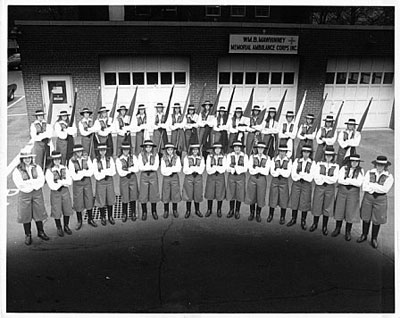 Breaking from the category of an “all male” corps, the Muchachos opened the color guard ranks to young women. The quality of members coming from local high schools and competitive color guards was astounding. The bold red of the guard uniforms would complement the look of the corps. The May 30th early show saw Hawthorne in fifth place, not nearly where they hoped to be. By September 1971, the corps was prepared to travel to Houston, Texas for the American Legion Nationals. The corps placed 4th in the Astrodome which proved to be an acoustical challenge for the corps. At season’s end, the corps saw an influx of talent and they began preparation on a new show that they hoped would turn heads over the next season….a season when Drum Corps would change significantly. Breaking from the category of an “all male” corps, the Muchachos opened the color guard ranks to young women. The quality of members coming from local high schools and competitive color guards was astounding. The bold red of the guard uniforms would complement the look of the corps. The May 30th early show saw Hawthorne in fifth place, not nearly where they hoped to be. By September 1971, the corps was prepared to travel to Houston, Texas for the American Legion Nationals. The corps placed 4th in the Astrodome which proved to be an acoustical challenge for the corps. At season’s end, the corps saw an influx of talent and they began preparation on a new show that they hoped would turn heads over the next season….a season when Drum Corps would change significantly.
1972 would offer a new environment for drum corps in America. Drum Corps International was formed in order to provide a more creative venue and the Muchachos took the opportunity to move drum corps into unexplored territory. Drill writer Frank Gerris, in reviewing the rules of competition, noted that re-entry into the field was not prohibited. The first show of the year was a surprise to the judges and audiences alike as the Muchachos left the field during their exit number, “Fanfare for the Common Man”, only to turn around and charge the stands with a reprise of “Espiritu del Toro”. A new standard had been set for corps in the future as end zone fanfares became a thing of the past.
The summit was finally conquered as the Muchachos won the first New Jersey State Open Championships in 1972. Then, in their highest ranking in major competition, the Muchachos won the World Open Prelims, only to drop to third in the evening finals. But the stage was set for the corps participation in the first Drum Corps International World Championships. The Muchachos was the first corps to perform in prelims. Even in this undesirable position, they performed well enough to shoot them into the finals where they finished in 10th place. The power of the opening number, “Espiritu del Toro”, impressed the large audience and the balance of the show was just as enjoyable and spirited. The Muchachos were now seen as one of the premier corps in the country with a bright future ahead.
 1973 began with a loss to the 27th Lancers followed by an unbroken string of twelve first place finishes with scoring in the mid-eighties Local competitions were the proving grounds for the corps. The corps placed first in Audubon, Cranford, Wilmington, Garfield, Union City, Westwood, Demarest and Boston. Along with the Caballeros, the Muchachos won the coveted Dream Contest. That July, Drum Corps News stated under the headline “Muchachos Continue Jersey Dominance” that the corps presented a “field show that defies adequate description in words. Difficult music matched with imagination”. Other reports stated that they were “one of the corps from the east to be reckoned with in the national junior championships”. DeLucia’s percussion ensemble was most impressive. “…solo (Kouyou Dance) is so good that the percussion section deserves the bow they take…” – Drum Corps News. After the Garfield Invitational, the News stated that “the stealer of the show was the Hawthorne Muchachos. The horns were up tight and the drums were out of sight”. 1973 began with a loss to the 27th Lancers followed by an unbroken string of twelve first place finishes with scoring in the mid-eighties Local competitions were the proving grounds for the corps. The corps placed first in Audubon, Cranford, Wilmington, Garfield, Union City, Westwood, Demarest and Boston. Along with the Caballeros, the Muchachos won the coveted Dream Contest. That July, Drum Corps News stated under the headline “Muchachos Continue Jersey Dominance” that the corps presented a “field show that defies adequate description in words. Difficult music matched with imagination”. Other reports stated that they were “one of the corps from the east to be reckoned with in the national junior championships”. DeLucia’s percussion ensemble was most impressive. “…solo (Kouyou Dance) is so good that the percussion section deserves the bow they take…” – Drum Corps News. After the Garfield Invitational, the News stated that “the stealer of the show was the Hawthorne Muchachos. The horns were up tight and the drums were out of sight”.
The corps would place 3rd in the DCI East Championships behind two of the best corps in history, the Santa Clara Vanguard and the Casper Troopers. Back in Whitewater, Wisconsin for the second year, the corps moved into fifth place at prelims, only to fall three points in finals, ending up in eighth place. Still an improvement over 1972, the corps was not satisfied with the result and would look to 1974 as the next stepping stone. Upon their return to New Jersey, the Muchachos won the State Open Championships for a second year but lost the American Legion State Championships to the Bridgemen by five-hundredths of a point.
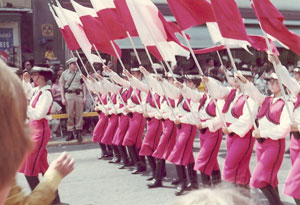 In 1974, the quality of the corps was notched up again with the growing talents in all sections of the corps. The music was exciting, emotional and creative. From the original composition “ Picturas De Espana” by Larry Kerschner and the up tempo concert of “Malaguena”…. the party number of the year “Carnival / Marianne” highlighted by the soprano solos of Jeff Kievit to the haunting chords of “Concerto de Aranjuez” the repertoire was packed with crowd pleasing music. In 1974, the quality of the corps was notched up again with the growing talents in all sections of the corps. The music was exciting, emotional and creative. From the original composition “ Picturas De Espana” by Larry Kerschner and the up tempo concert of “Malaguena”…. the party number of the year “Carnival / Marianne” highlighted by the soprano solos of Jeff Kievit to the haunting chords of “Concerto de Aranjuez” the repertoire was packed with crowd pleasing music.
Early season ‘74 had the corps winning by wide margins over local corps. As the major shows approached, the corps felt this would be the year for them to challenge the powerhouse units from the west and mid-west. The DCI East Championship was claimed by the Muchachos with a six point margin over their nearest competitor, the Garfield Cadets (83.65 to 77.60). Next up was the CYO Nationals where the Muchachos matched talents with six corps outside of the eastern region. The corps ranked 5th, some two points behind the winning Madison Scouts. The World Open Championships ended with the corps in 3rd place behind the Anaheim Kingsmen and Racine Kilties. Again the corps proved their right to be among the finest in the land. The Dream Contest would be captured by the Muchachos for a third consecutive year as their quest continued.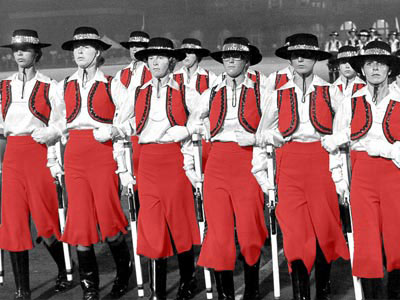
Ithaca, N.Y. was the site of the third Drum Corps International Championships. Due to their position in the Preliminaries, the corps scored lower than hoped for and they found themselves in 7th place entering the Finals. The stadium was electric for the championships as the “hometown” crowd looked for a corps that could challenge the western corps. One of the finest recordings of the Muchachos is the DCI Finals where, from the opening introduction by the announcer to the final fanfare, the crowd is heard cheering and chanting “east, east, east”. The corps responded to the enthusiastic support and climbed three spots that night ending up in fourth place behind the Santa Clara Vanguard (1973 Champions), the Madison Scouts (1975 Champions) and the Anaheim Kingsmen (1972 Champions). The brass line had performed so well, they were able to claim 2nd place. And once again, the State Championship was captured by the Muchachos.
This had truly been “A Very Good Year”.
The winter of ’74-’75 was very encouraging. With growth in all sections of the corps, the Muchachos would field 135 marching members in 1975. The quality of the corps was evident as the season progressed. The season opened with a win over the 27th Lancers and Garfield Cadets. The Muchachos produced a wall of sound with their 56 brass and 30 percussion and the visual masterpiece was accented by the 40 talented guard members. The unbroken string of wins continued through the early summer months. In August, Drum Corps News published a rating of national drum corps with the top rating, the “5 star corps”, going to the Santa Clara Vanguard, the Blue Devils, the 27th Lancers and the Hawthorne Muchachos. As the major shows fell into place, the Muchachos placed from first to fourth depending on the show. The one corps to beat at the DCI Championships appeared to be the Madison Scouts. Every other corps had fallen to the Muchachos along the way. The opportunity had come to become the top corps in the nation. The preliminary performance was seen as the best of the season. It was a quality performance that rumors claim captured the top score. But it was not to be, as the DCI organization determined that an over-aged member had performed, resulting in the disqualification of the Muchachos from the competition. This was a shocking outcome for the corps and the fans alike. The Madison Scouts would claim the title that year. The corps would return to New Jersey to claim the State Title, but it was an anticlimactic win. In overview, 1975 was the best year in the corps existence, but the question remained if the Muchachos could come back from such a devastating event.
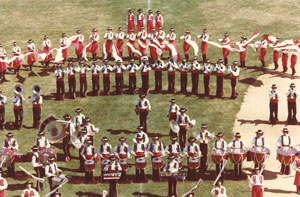 The winter months saw the Muchachos attempt to build on the previous season’s positive accomplishments and not dwell on the one “bump in the road”. Having forfeited the prize money of the DCI Championships, the financial well-being of the corps was in question and much work lay ahead to field another quality corps in 1976. The winter months saw the Muchachos attempt to build on the previous season’s positive accomplishments and not dwell on the one “bump in the road”. Having forfeited the prize money of the DCI Championships, the financial well-being of the corps was in question and much work lay ahead to field another quality corps in 1976.
At the beginning of the season, Drum Corps News reported that the Muchachos were “still displaying the sparkle which excited this fraternity for many years…….alive and well in the season opener.” But the season would be full of ups and downs, changes in the program and disappointing results. The first competition saw the Muchachos winning, one tenth of a point over the Garfield Cadets. Two weeks later, the Cadets would beat the Muchachos by two points. The Cadets and Bridgemen would open the gap as the season moved forward. Third in the Dream, sixth in the World Open, eighth in the CYO Nationals and fourth in the VFW Nationals would be their fate. The Muchachos would place 21st in the DCI Prelims out of forty-seven competitors. The low placement would affect the draw of new members to the corps over the next winter. The outcome for 1977 was in question.
On July 2, 1977 the Muchachos made their first performance of the year. Early Drum Corps News articles were encouraging but as scores began to mount, it was apparent that the corps had experienced a devastating set back. The UOEC Championships found the corps in last (10th) place, over twenty points behind the Bridgemen. In the American International Open, they placed 7th of twelve, 5th at the Dream and at the CYO Nationals, 11th of twelve. The corps was scoring in the sixties and had difficulty improving the scores. This would be the end of the journey for the Muchachos. They would enter the archives of Drum & Bugle Corps history as a corps exhibiting great class, pride and talent over two decades.
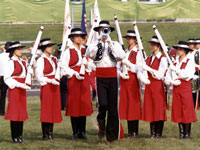 Over the years that followed, many of the staff and performers would continue with other corps or marching bands or would become professional musicians. Some would enter adjudication and some would simply become fans. Several reunions would bring the corps together to remember their accomplishments. The corps still “lives” through audio and recently discovered video recordings. Dedications to the corps, such as that by their “big brother” Caballeros, still move the fans of the Muchachos. For certain, the Hawthorne Muchachos will remain one of the premier corps of all times and their mystique will endure. Over the years that followed, many of the staff and performers would continue with other corps or marching bands or would become professional musicians. Some would enter adjudication and some would simply become fans. Several reunions would bring the corps together to remember their accomplishments. The corps still “lives” through audio and recently discovered video recordings. Dedications to the corps, such as that by their “big brother” Caballeros, still move the fans of the Muchachos. For certain, the Hawthorne Muchachos will remain one of the premier corps of all times and their mystique will endure.
---
This historical recollection is dedicated to all who have passed but who will be remembered as being a “Muchachos”, including Ray Cortazzo who was the first corps member to pass away as a very young man following the Miami Nationals in 1961.
History of the Hawthorne Muchachos Junior Drum & Bugle Corps
Hawthorne, New Jersey, 1959 – 1977 ©2011 by William Barlics |
|
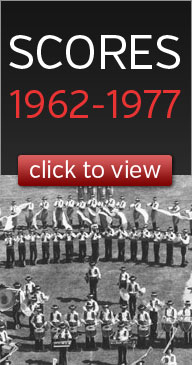
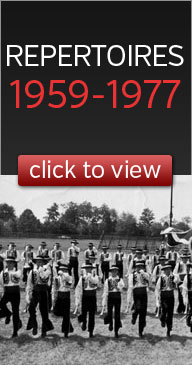

|


